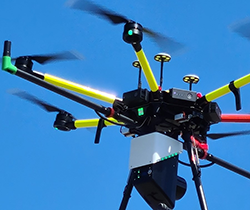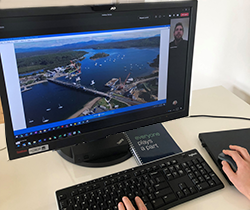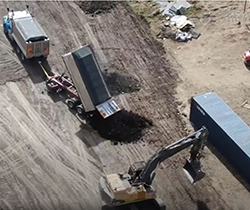EPA’s eyes in the sky
Drone technology is assisting the EPA with remote compliance inspections as well as providing vital evidence for breaches in regulatory practice.

Drones are helping the EPA to safely and efficiently access sites remotely for compliance
The EPA’s use of drones has increased over the past year as we navigate the safety of staff during COVID-19 restrictions.
Executive Director Regulatory Practice and Environmental Solutions David Fowler said the EPA had been using drones to monitor pollution, get a visual of incidents where it was dangerous to enter, and view illegal dumping in difficult to reach terrain, for a number of years.
“Drones are helping us access spaces that we couldn’t cover operationally - and we can see them being more and more central to our regulatory work."
Drones facilitate remote compliance checks on major construction
In southern NSW, the EPA’s Andreas Stricker is using drone imagery to remotely assess whether the construction of the Batemans Bay and Nelligen bridges are meeting their environmental obligations, under their licence issued by the EPA.

EPA uses drone footage to help licensees complete compliance checks on construction sites
“We would normally attend the checks in person but with the COVID safety rules, we are using a mix of drone imagery and hi-quality images to monitor the progress construction,” Andreas said.
“Both bridges are located within the Clyde River catchment, a sensitive receiving environment with important living organisms and high conservation values.
“The Catchment includes oyster farmers who can be significantly impacted in the event of a pollution incident.
“We requested the licensee to take the drone imagery and booked in a virtual meeting with the them to talk through the imagery, raising key points as they went along.
“We are just about to have our third inspection using this methodology.”
Drone surveillance leads to $270,000 in penalties
Watch the drone and surveillance footage that assisted the prosecution!

Drones are helping the EPA to safely and efficiently access sites remotely for compliance
Liverpool Local Court in August convicted and fined Mr Fouad Arja for waste and pollution offences at a rental property in Rossmore, following successful prosecution by the EPA.
The convictions come after a complex investigation conducted by the EPA which relied upon covert surveillance footage obtained from drones and CCTV, as well as a search warrant conducted with NSW Police.
EPA Executive Director Regulatory Operations Carmen Dwyer said the EPA acted on a tip-off from Liverpool City Council and the community.
“After officers became aware of potential offences by the defendant, EPA drone surveillance revealed extensive stockpiling of a variety of waste, and also captured trucks delivering suspected demolition waste material,” Carmen said.
“Testing of some of the waste material revealed it was contaminated, with the presence of asbestos detected.”
“The EPA is warning anyone trying to hide contaminated waste that it will use the best technology to ensure human and environmental health is protected.”
The EPA is working to ensure the premises is remediated and made safe. Read more

